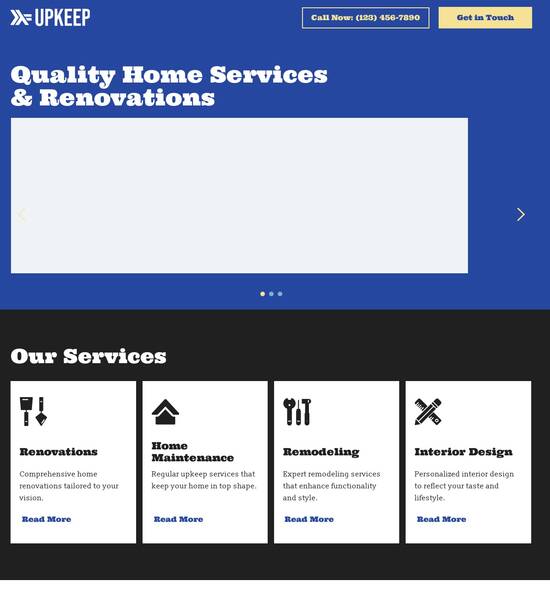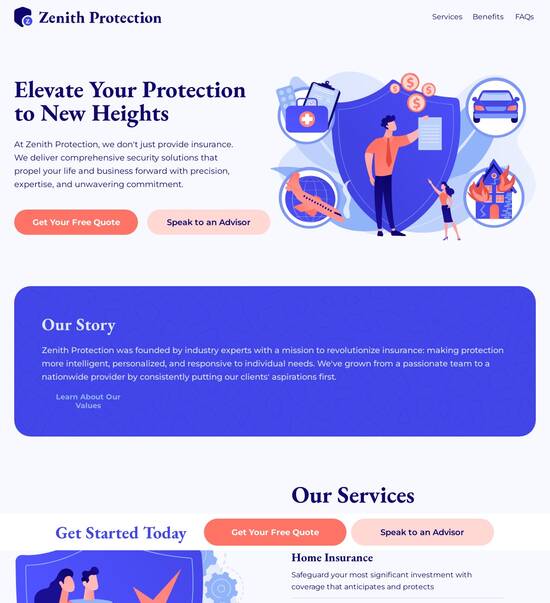
Ruby reporting page template
Explore Similar TemplatesAbout template
Discover a stylish ruby reporting page template that reflects your unique style!
Recommended templates

Easy to build without coding
With the intuitive drag-and-drop builder, anyone on your team can create high-converting pages without any knowledge of code or design. Make enhancements to your landing page with custom widgets using Javascript, HTML/CSS, or third-party scripts.

Multiple layouts for any industry and goal
Select from 500+ landing page layouts built to boost conversions across industry-specific scenarios. Customize them by adjusting fonts, adding images, and generating on-brand content with the AI assistant. Quickly scale with Instablocks® and Global Blocks that you can save, reuse, and update globally.

Loads fast and looks polished on any device
Every template is responsive, which means they present professionally on any device and load blazingly fast with our Thor Render Engine. You can also power them up with Google AMP technology to deliver an unparalleled mobile experience and drive higher conversions.

Robust analytics & experimentation
Get real-time updates and reporting across all your devices, showing the number of visitors, conversions, cost-per-visitor, and cost-per-lead. Launch AI-powered experiments, run A/B tests, and use heatmaps to analyze user behavior, then optimize your landing page to maximize conversions.







Easy to build without coding
With the intuitive drag-and-drop builder, anyone on your team can create high-converting pages without any knowledge of code or design. Make enhancements to your landing page with custom widgets using Javascript, HTML/CSS, or third-party scripts.
Multiple layouts for any industry and goal
Select from 500+ landing page layouts built to boost conversions across industry-specific scenarios. Customize them by adjusting fonts, adding images, and generating on-brand content with the AI assistant. Quickly scale with Instablocks® and Global Blocks that you can save, reuse, and update globally.
Loads fast and looks polished on any device
Every template is responsive, which means they present professionally on any device and load blazingly fast with our Thor Render Engine.
Robust analytics & experimentation
Get real-time updates and reporting across all your devices, showing the number of visitors, conversions, cost-per-visitor, and cost-per-lead. Launch AI-powered experiments, run A/B tests, and use heatmaps to analyze user behavior, then optimize your landing page to maximize conversions.
All the features you need to build lead-generating landing pages
Explore more featuresLearn how to build top-performing landing pages for any goal
FAQs
Leading the way in building high-performing landing pages





A step-by-step guide to utilizing Instapage for success
Navigating the digital landscape requires a robust platform that empowers marketers to create landing pages that convert. Instapage is the most powerful landing page and CRO platform, designed to help businesses accelerate and scale their marketing campaigns. This guide offers a comprehensive walkthrough to effectively use Instapage, highlighting the unique benefits tailored to various industries such as tech/SaaS, education, and others across the USA.
Step 1: Accessing templates and lead generation elements
Begin by exploring Instapage's extensive library of over 100 high-converting templates. These templates are crafted for various industries and are designed to capture leads and drive impactful results. Using the intuitive drag-and-drop builder, you can customize any template to suit your brand's needs seamlessly. This eliminates the need for coding skills, allowing you to launch effective landing pages quickly.
- Diverse templates: Choose from layouts that fit your specific marketing needs.
- Easy customization: Modify elements effortlessly to align with your brand identity.
- Lead generation: Utilize built-in forms to capture leads directly from your landing pages.
Step 2: Building optimized landing pages
Once you have selected your template, it’s time to build your landing page. Utilize the conversion-focused layouts and Instablocks available within Instapage. This flexible platform allows marketers to develop effective pages without the need for a developer's assistance. The user-friendly interface encourages creativity while maintaining a focus on driving conversions.
- Conversion layouts: Use layouts that have proven effective in generating leads.
- Instablocks: Save and reuse custom-built blocks across different landing pages.
- Mobile optimization: Ensure your pages are responsive and visually appealing on all devices.
Step 3: Personalizing content for targeted audiences
Creating personalized content enhances engagement and conversion rates. With Instapage's dynamic text replacement feature, you can tailor experiences to your audience based on their interests and behaviors. Align specific ads to related landing pages through AdMaps, and utilize analytics tools to track user interactions and optimize further.
- Dynamic content: Modify text based on user data to create customized experiences.
- AdMaps: Connect ads with tailored landing pages to enhance relevance.
- Audience metrics: Analyze data to refine targeting and improve performance.
By following these steps, marketers can leverage Instapage's capabilities to create high-performing landing pages that cater to their audience's needs, driving better results for marketing campaigns.
To unlock the full potential of your digital marketing strategy, start using Instapage today to create stunning landing pages that convert.
Explore the full features of Instapage now and transform your marketing campaigns into success stories!
Understanding Ruby reporting page templates for effective data presentation
Understanding Ruby reporting page template: A functional overview
A Ruby Reporting Page Template serves as a structured framework designed specifically to streamline the generation and presentation of data reports. These templates are built using the Ruby programming language, enabling developers to craft dynamic and interactive reports that can cater to diverse business needs. Through the utilization of various Ruby libraries and frameworks, these templates can harness the full potential of data, offering users clear and actionable insights that play an integral role in decision-making.
These templates consist of key components which include data models, views, and controllers, collectively ensuring a well-organized pipeline for pulling data, processing it, and rendering it in a user-friendly format. This modular approach not only enhances reusability but also simplifies maintenance, allowing teams to easily update or modify components as reporting requirements evolve.
Templates facilitate the rapid generation of reports.
They provide customizable layouts suitable for various industries.
Ruby's community support enhances the development process through shared tools and libraries.
The role of Ruby in web development
Ruby is a dynamic, object-oriented programming language that has gained popularity since its inception in the mid-1990s. Its emphasis on simplicity and productivity makes it a preferred choice among developers working on web applications, particularly through the Ruby on Rails framework. Rails, known for its convention over configuration principle, enables developers to create robust applications efficiently, emphasizing readability and maintainability.
Choosing Ruby for reporting in web applications allows developers to leverage its expressive syntax, making code easier to write and understand. This results in reduced time for development cycles, which is crucial for businesses needing to adapt quickly to changes in data presentation or reporting requirements. Furthermore, the large Ruby community offers a wealth of libraries and gems, simplifying the integration of complex reporting functionalities into applications.
Key features of Ruby reporting page templates
One of the standout features of Ruby reporting page templates is their capability for dynamic data handling. Real-time data generation allows organizations to produce reports that reflect the most up-to-date information. This is particularly important in sectors like finance or marketing, where timely insights can lead to swift decision-making and strategic advantages. Ruby's integration capabilities with various databases and data sources, such as MySQL, PostgreSQL, or even external APIs, enhance this feature, ensuring that developers can pull data from multiple avenues effortlessly.
In addition to real-time data handling, customization options available within these templates allow businesses to tailor reports according to user needs. By using a variety of layouts and themes, developers can enhance visual appeal and ensure reports are not only informative but also engaging. This customization extends to defining filter options, sorting criteria, and even specific data visuals like charts or graphs.
Pivot tables allow for detailed data analysis within reports.
Data visualization tools enhance user comprehension of complex datasets.
File export options, including PDF and Excel formats, are crucial for reporting.
Lastly, advanced reporting techniques offered by Ruby templates enrich the reporting experience by integrating visual analytics features. Users can create pivot tables, implement interactive charts, and incorporate data visualizations directly into reports, enhancing the overall comprehension of data insights. Furthermore, the ability to generate downloadable formats such as PDF and Excel ensures that reports can be easily shared and utilized across different platforms and audiences.
Implementation processes and best practices
Creating a Ruby Reporting Page Template involves several critical steps. First and foremost, developers need to set up the environment properly, which typically includes installing Ruby, setting up a Ruby on Rails framework, and configuring database connections. By following the conventional directory structure of Rails, developers can organize their reports effectively, making future updates and maintenance much more straightforward.
The next step involves structuring the template itself. This includes identifying the necessary components such as models for data fetching, views for display, and controllers to manage the interaction between them. Code snippets written in Ruby will be essential for executing database queries and formatting the output, ensuring that the report contains all relevant information in a clear layout. Following this, developers should focus on optimizing performance to manage load speeds and ensure responsiveness.
Implement efficient data fetching strategies to minimize database load.
Utilize caching mechanisms to enhance speed for frequently accessed data.
Consider lazy loading techniques for larger datasets to improve initial load times.
Engaging with the developer community
Engaging with the Ruby community is a powerful way to enhance your knowledge of reporting page templates. Numerous online collectives and forums, such as Stack Overflow and the Ruby on Rails subreddit, offer platforms for developers to exchange insights, ask questions, and share solutions. Participating in these communities not only helps developers overcome challenges but also promotes a culture of collaboration and learning.
Contributing to open-source projects or local meetups can further enrich a developer's experience. Collaboration on reporting projects often involves using shared repositories and version control systems like Git. Using these tools effectively ensures that teams can track changes, manage contributions seamlessly, and maintain the integrity of the codebase throughout the development process.
Join discussions on forums to stay updated on best practices and trends.
Share resources and tools that simplify reporting template development.
Attend Ruby conferences and webinars to network with peers.
Addressing common questions and solutions
When developing Ruby reporting page templates, developers often face a range of common challenges. Issues related to data fetching, performance optimization, and integration with third-party APIs can frequently arise. To tackle these concerns, understanding the intricacies of Ruby's data handling capabilities and the best libraries for integration can be highly beneficial.
Moreover, community insights can provide effective workarounds. Engaging directly with experienced developers can lead to discovering innovative solutions and learning about efficient error-handling practices in reporting applications. Utilizing platforms designed for Q&A, such as GitHub Discussions or dedicated Slack channels, can connect developers with experts who have faced similar challenges.
Attend developer meetups or webinars to learn about common pitfalls.
Create a resource bank of solutions for recurring issues you encounter.
Foster a mentorship approach within your team to encourage sharing of knowledge.
Real-world applications and case studies
Ruby reporting page templates have found extensive application across various industries, including finance, marketing, and education. These templates are instrumental for businesses needing to generate detailed reports for clients, stakeholders, or internal analysis. For instance, a financial services company might deploy a Ruby reporting template to produce monthly performance reports for its investors, integrating real-time data analysis and visual charts to enhance comprehension.
Successful case studies highlight organizations that made significant improvements in their operational efficiency after implementing Ruby reporting templates. One notable example is a marketing agency that transitioned from manually generating reports to utilizing Ruby templates. This shift resulted in a 30% reduction in report preparation time and allowed them to focus more on strategic planning and client engagement.
Industries such as healthcare, where real-time data tracking is critical.
E-commerce platforms generating sales reports dynamically.
Educational institutions analyzing student performance data.
Innovations and future trends
As technology evolves, so too does the landscape of Ruby reporting page templates. Emerging innovations, particularly in artificial intelligence and automation, are set to revolutionize how data is handled in reports. Utilizing machine learning algorithms to analyze user behavior can lead to increasingly personalized reporting templates that adapt to user preferences and improve engagement.
Additionally, future trends may involve broader integrations with cloud services, allowing for more streamlined data collection and processing. This change can further enhance the user experience by ensuring reports are always based on the most current information, with updates occurring seamlessly in the background.
AI-driven features to automatically suggest data visualizations.
Cloud-based reporting for real-time data integration.
Greater emphasis on security for protecting sensitive data.
Localization and accessibility considerations
For Ruby reporting page templates to be effective, they must adapt to local contexts. This often involves incorporating multilingual reporting features, which can cater to diverse audiences across different regions. By allowing reports to be generated in various languages, businesses can ensure that all stakeholders have access to important data without language barriers.
Accessibility is another critical consideration. Ensuring that reporting templates meet accessibility standards is vital for inclusivity. This involves following established guidelines such as the Web Content Accessibility Guidelines (WCAG) to create user-friendly reports for individuals with disabilities, thereby fostering a broader reach and engagement with varied audience segments.
Implement user interface designs that accommodate screen readers.
Use alt text for images and diagrams in reports.
Regularly test reporting templates for usability and accessibility.
Ready to skyrocket conversions?
Supercharge your ad campaigns with high-performing landing pages
Get started














